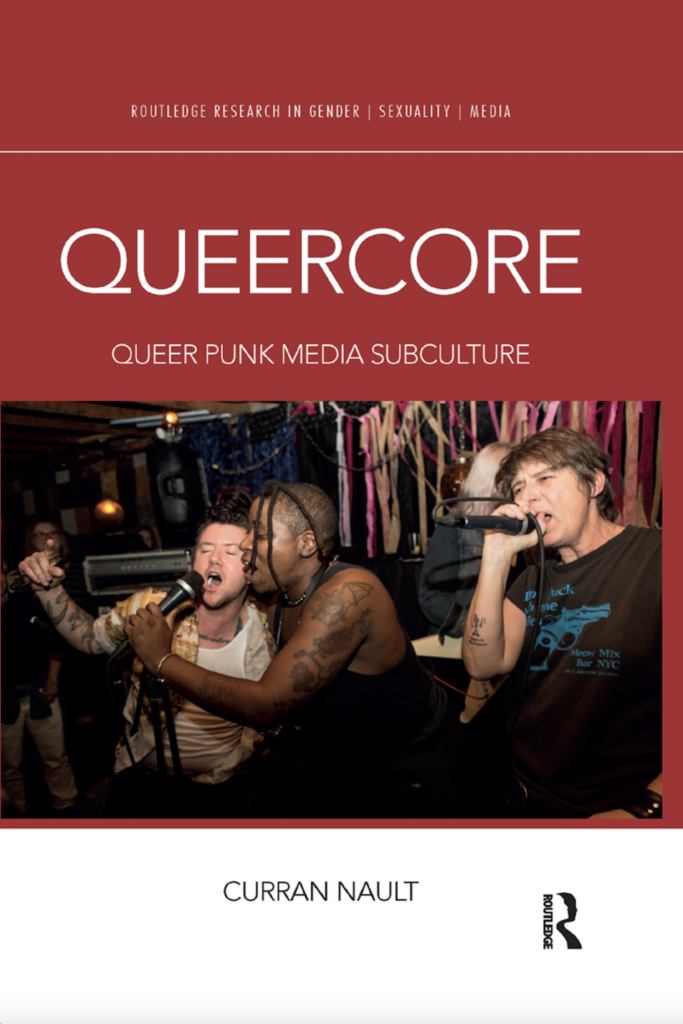by James Gabrillo

Midway into Queercore: Queer Punk Media Subculture (Routledge, 2018), author Curran Nault introduces us to Tribe 8. Formed in San Francisco in 1991, the band performed on-stage antics that embodied gender rage and confrontational eroticism — stunning spectacles of sadomasochistic fantasies and sex toy castrations.
Their act was emblematic of queercore, a subculture of artistically minded gender dissidents who adapt the practices of the punk movement to challenge the oppressions of mainstream society. But Nault, an Assistant Professor in the Department of Radio-Television-Film at UT Austin, goes beyond the perfunctory acknowledgment of Tribe 8’s contributions to offer a deeply sensitive dissection of the power of queercore’s “button-pushing bluster”.
Tribe 8’s penchant for shock — for the parodic skewering of macho posturing — was an affective release, but also a manifestation of punk’s taste for unnerving disobedience. Invoking Jack Halberstam’s notion of imagined violence — or symbolic expressions of aggression on the part of queer subjects — Nault regards Tribe 8’s performance as “a kind of negotiation, and ultimately a purging, of the psychosexual traumas of patriarchy” (122).
Such careful consideration of Tribe 8 is just one of many compelling case studies in Queercore, a stellar account of the radical antiestablishment movement during its first two decades (1985 to 2006). In lively prose, Nault traces queercore’s thematic contours through extensive archival work and interviews with pioneers and practitioners, linking them to discourses on community-building and social justice.
We’re treated not only to a rich probe of the intertwined histories of queer and punk, but also to insightful excavations of crude sexual representations, confrontational political tactics, and subversive body politics. Nault sculpts the narrative with the help of gender and racially diverse artists — including initial instigators G. B. Jones and Bruce LaBruce — and multimedia artifacts like zines, films, and of course musical performances.
Aside from his scholarly work, Nault is also the co-founder and artistic director of OUTsider (http://www.outsiderfest.org), a transmedia non-profit that stages an annual five-day festival celebrating the creativity of queer communities in Austin and beyond. The festival strives to develop opportunities for “queer togetherness”, an operation that Nault enacts, too, through his book’s impressive location of an underground subcultural phenomenon and its community of faces and paraphernalia.
In Queercore’s closing chapter — elegantly titled “A Queer Elegy for the Future” — Nault recounts a moment from the first OUTsider festival staged in 2015. Awarding the inaugural OUTsider Legacy Award to Tribe 8, Nault lionized the band for having “held a space in the far corners of the ‘outside’ and then welcomed us into their musical misfit haven.”
In recording this very haven, Nault has preserved a radical collective’s intimacies and legacies. “Queercore still has much to teach us about the beauty of creating communities and artworks with like-minded wackadoos,” Nault muses, “[and] about the benefit of doing-it-yourself in a culture that wants us to remain passive consumers” (167). His book sets the ball rolling for more of queercore’s furious fun and profound politics.

James Gabrillo joins UT Austin’s Butler School of Music as assistant professor of musicology and ethnomusicology this coming fall semester. He previously taught at The New School, finished a postdoc fellowship at Princeton, and earned a PhD in music at the University of Cambridge. More information at www.jamesgabrillo.com.
